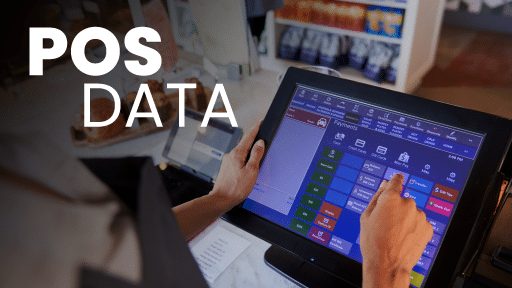Unlocking the wealth of data provided by retail POS systems, from customer preferences to inventory management, can revolutionize retail decision-making. This guide demystifies POS data and highlights what you can gain by utilizing it. By the end, you’ll be equipped to unlock the full potential of your POS system and gain a competitive edge in the market.
💡 Key Takeaways:
- Every POS system collects large amounts of transactional data after the customer has paid. This data helps retailers streamline their operations and inventory management.
- There are several key types of POS data that, when analyzed, can streamline your retail operation’s decision-making.
- Best practices like centralizing data, regularly backing up information, and maintaining robust security protocols are essential to ensuring the accuracy and safety of your POS data.
- We offer real-world examples to demonstrate how POS data analysis can lead to more effective operations across the board.
What is POS Data?
POS data is the information collected at the point of sale. With features like POS reporting and analytics, businesses can use their POS systems to track data like sales metrics, inventory turnover, employee performance, key performance indicators (KPIs), and much more.
There are seemingly infinite possibilities when it comes to leveraging and analyzing POS data. Programs like KORONA POS offer tools to unlock the full potential of this data so you can enhance your decision-making, retail operations, and customer relationship management (CRM).
9 Types of POS Data to Analyze
Understanding and analyzing specific types of POS data can empower retailers, putting them in the driver’s seat of their retail business. Here are nine POS data types that can give you the control and confidence to make meaningful business decisions:
1. Sales Data
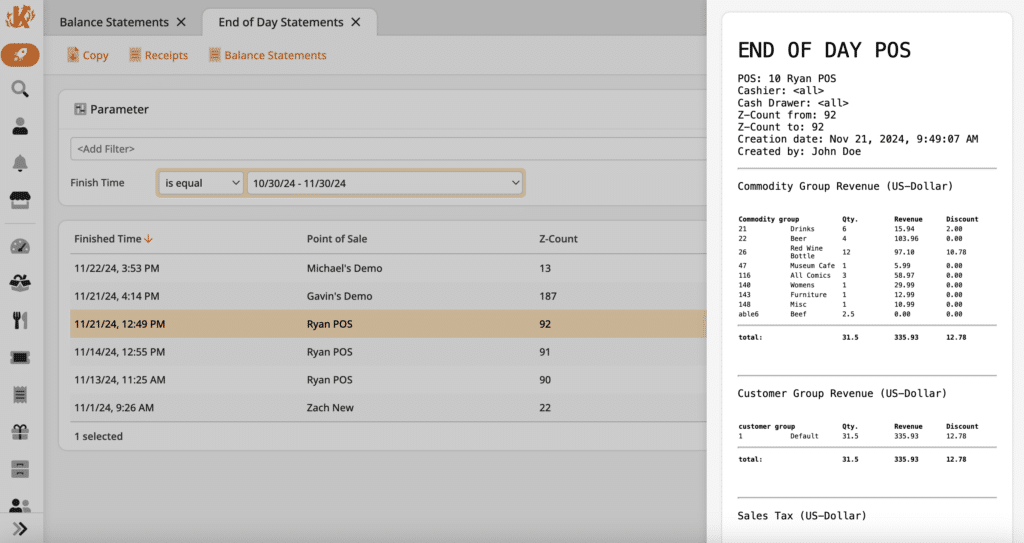
Retailers can track sales data to understand daily, weekly, and monthly sales trends to identify best-selling products and forecast consumer demand. Sales data fits neatly into retail daily sales reports or inventory spreadsheets, which help retailers make data-driven decisions about inventory and pricing strategies.
2. Transaction Data
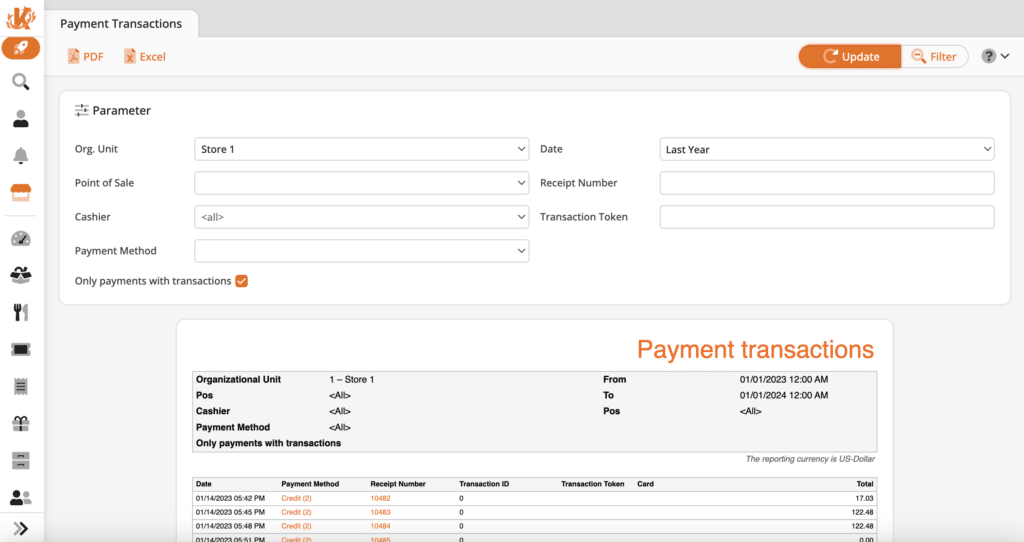
Transaction data is different from sales data. It shows users the transaction amount, payment type, and type of transaction per sale.
Retailers can track transaction data to understand customer purchase intent. For example, did the customer buy a singular object or several items? Did they use a cash or a card? Knowing these data enables retailers to confidently refine their sales strategies and enhance customer engagement and experience in hyper-specific ways.
3. Product Data
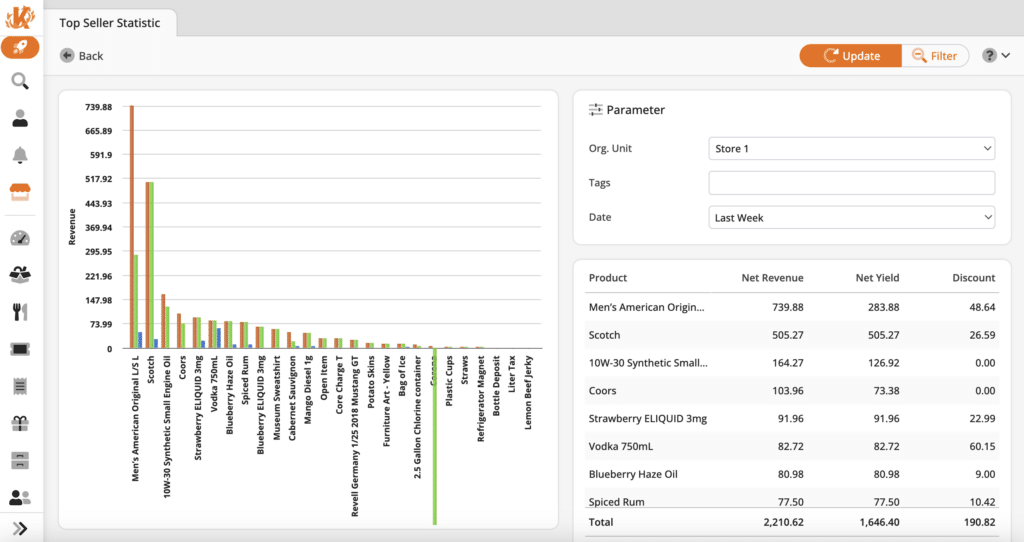
Product data is the information obtained about each product item during a transaction.
It looks at what customers bought, the quantity purchased at a time, the amount spent on the product, and what it was purchased with.
Retailers can use this information to understand sales value (how successful a product is over time) or how pricing affects a product’s popularity.
4. Customer Data
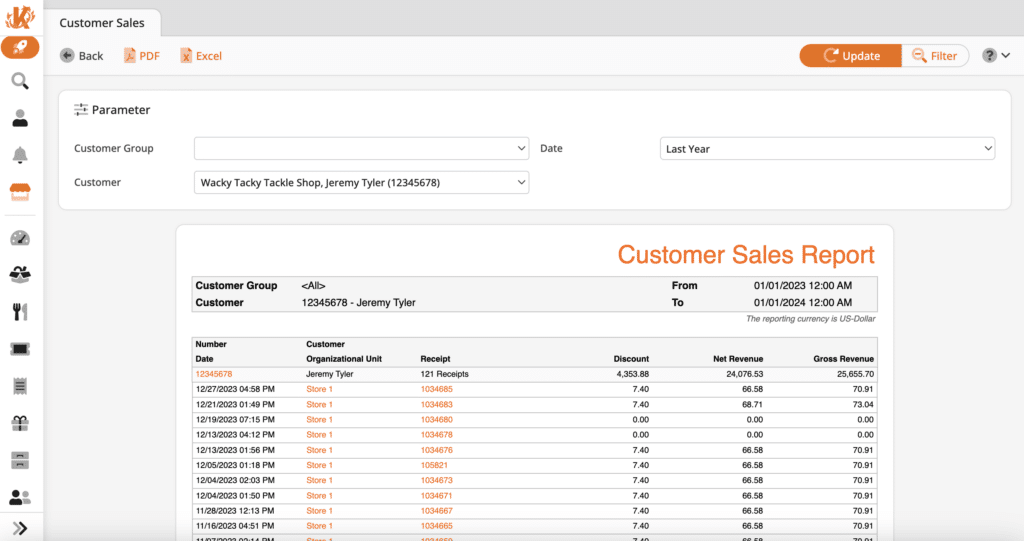
Retailers can use their POS system to analyze customers’ buying behavior, especially if they’ve signed up for a loyalty program.
You can learn how much a customer buys, what they spend, what brands they’re loyal to, what time of day they shop, and much more. Customer data is helpful to retailers in targeting promotions to the right people at the right time and refining marketing strategies.
5. Peak Hours Data

Peak hours data shows retail stores when their store has the highest foot traffic or when peak sales periods occur. Business owners can leverage this data to look at the time of sale, make decisions about staff scheduling, and optimize their retail inventory management system. Businesses can use peak hours data to create time-sensitive promotions and boost sales during off-peak times.
6. Location Data
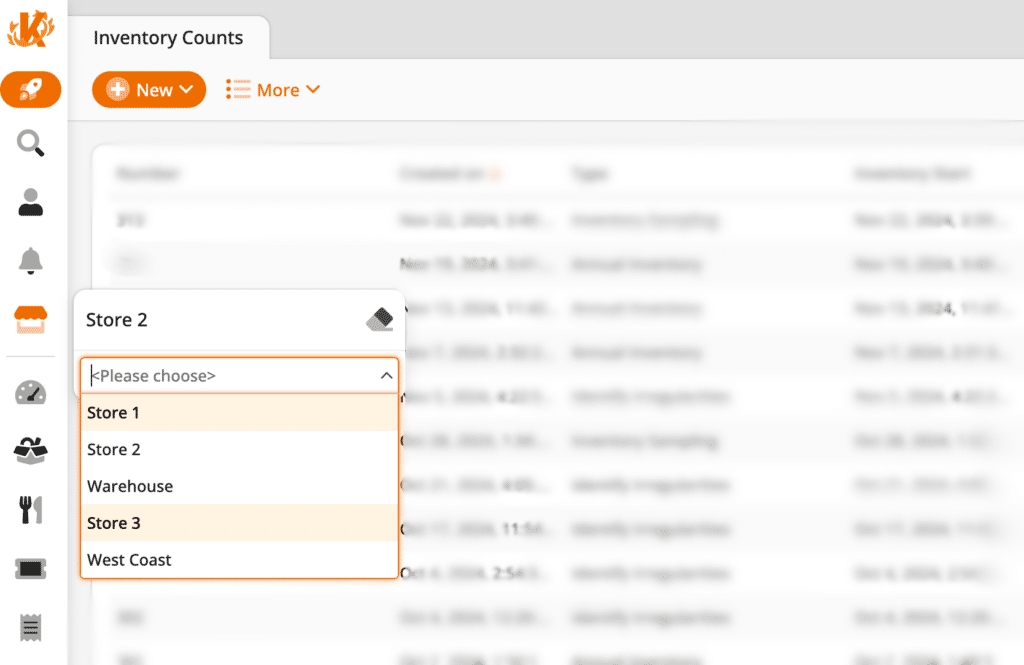
POS data can tell retailers exactly where a sale was made. This information can be as specific as a country, region, town, retail store, and even individual POS checkout station. For example, location data can tell you whether a purchase was completed at an employee-manned checkout or a self-service POS.
Location data helps retailers understand how sales perform by location and customer level. It also paves the way for targeted marketing strategy with a POS system, staffing decisions, or product promotions in specific store areas.
7. Discount and Promotion Data

POS users can use discount and promotion data to track retail sales performance, discounts, and promotions to evaluate their return on investment (ROI).
Discount and promotion data helps retail stores identify which offers resonate with customers by driving sales and which need adjustments.
8. Employee Performance Data
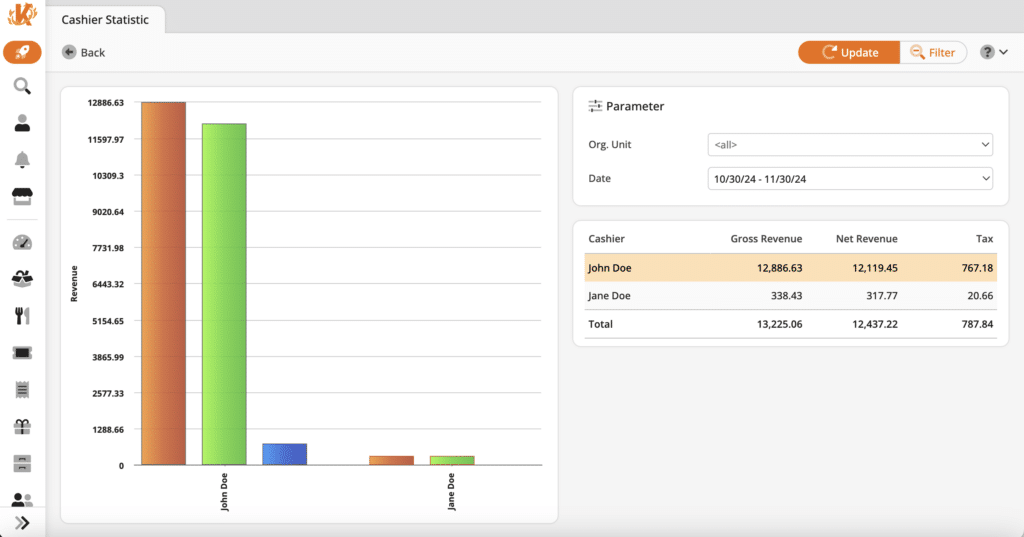
POS data enables retailers to track sales performance and identify top-performing employers. It can track metrics like individual sales, upselling success, transaction times, and customer satisfaction ratings.
Analyzing employee performance data helps retail stores identify top performers, address training needs, and align employee incentives with business goals. By leveraging this data, businesses can boost productivity and create a more efficient workforce.
9. Refund and Return Data
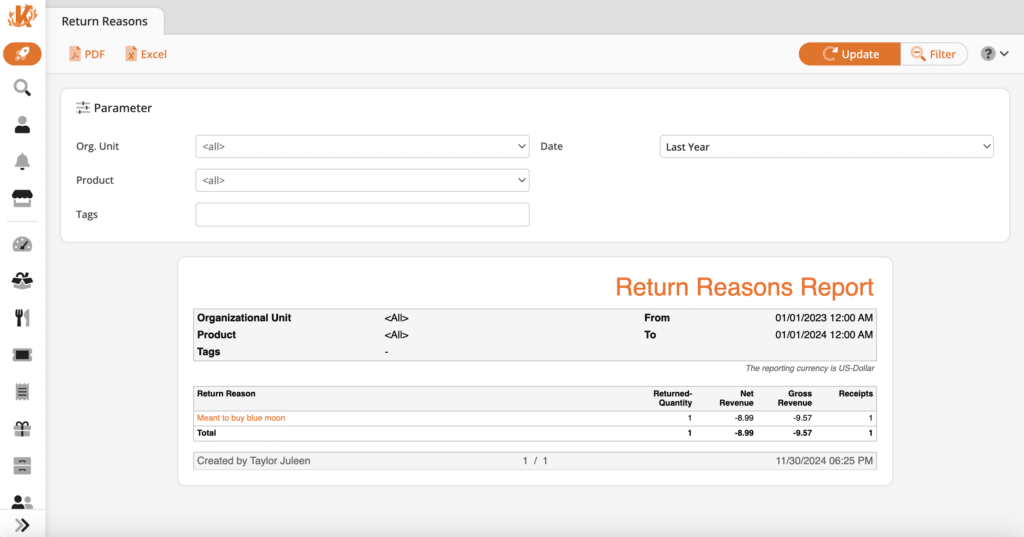
Refund and return data gives retailers deep insights into returned product patterns, why customers seek refunds, and the behavior associated with these transactions.
This data helps retailers identify which items are defective, have sizing inconsistencies, or have misleading product descriptions. Refund and return data helps retail stores reduce future returns, improving quality control and customer trust.
Examples of POS Data Analysis
POS data are not abstract concepts; they’re applied tools businesses use to streamline operations. Let’s take a look at POS data in action through some real-world examples:
Example 1: Inventory Optimization
Inventory Optimization
A boutique clothing retailer noticed through their POS system that certain seasonal items were overstocked while others sold quickly.
They identified the mismatch between customer preferences and purchasing strategy using inventory data. Using these insights, the retailer adjusted their orders for the following season, prioritizing popular items and reducing surplus stock levels. This resulted in a 20% decrease in carrying costs and a 15% increase in overall retail sales during the next seasonal period.
Example 2: Customer Loyalty Programs
Customer Loyalty Programs
A local coffee shop leveraged POS data to analyze customer purchase frequency and preferences. They found that customers who bought specialty drinks were more likely to return when loyalty rewards were offered.
By introducing a tailored rewards program offering a complimentary specialty drink after ten purchases, the shop increased customer retention by 30% within six months. The program also boosted average transaction values, as some customers opted for the higher-priced specialty drinks to engage in the rewards program.
Example 3: Employee Performance
Employee Performance
A mid-sized electronics store used POS data to track each employee’s sales performance and transaction times. The data revealed that employees with higher accessory upsell rates also had shorter transaction times.
Management implemented a training program where top-performing employees shared their strategies, leading to a 15% increase in accessory sales, improved sales efficiency, and camaraderie among the team.
POS Data Management Best Practices
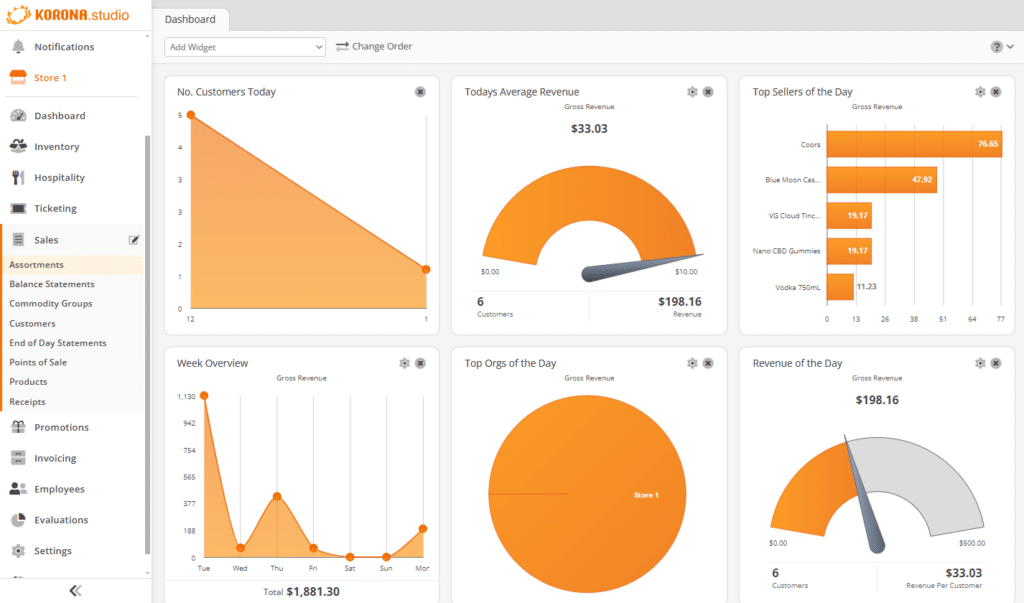
Without proper POS data management, businesses risk losing important sales information or falling victim to data breaches. Let’s take a look at which POS data management best practices can help retailers manage their data securely and effectively:
Best Practice 1: Centralize Data Storage
We recommend consolidating your POS data into a single, secure system to access your information in one place.
The best retail POS systems will centralize POS data for you. KORONA POS, for example, helps users reduce errors, cut wasted time, and report on sales and inventory trends more efficiently to make better decisions across locations and departments.
Best Practice 2: Regularly Backup Data
Ensure that all your POS data is backed up frequently on secure cloud servers or external drives. Data backups prevent loss due to system failures or cyberattacks.
Automated backups not only save ample time. They minimize human error and give retailers peace of mind, too. Businesses with cloud-based POS systems like KORONA POS can benefit from automatic backups and easy data restoration, even in emergencies.
Best Practice 3: Maintain Data Security Protocols
Implementing robust security measures, like encryption, multi-factor authentication (MFA), or user access controls, is critical to protect sensitive POS data.
We suggest regularly auditing the system for vulnerabilities and educating your staff on the best practices for handling sensitive customer information.
Best Practice 4: Regularly Organize Your Data
It’s essential to regularly review and clean your POS data by removing duplicate information, correcting errors, and standardizing your data formats across platforms. Doing so will help you make informed and accurate data-driven decisions.
For example, by regularly updating product names or SKUs in your POS system, you can ensure that your inventory reports are accurate and streamline your reordering processes.
Best Practice 5: Use Reporting Tools
Use your built-in POS analytics tools (or integrate third-party reporting software) to monitor essential metrics like sales trends, inventory levels, and consumer behaviors.
Visual dashboards make POS data interpretation easy and actionable. For example, KORONA POS offers customizable reporting features that help businesses track daily sales, optimize inventory, and assess the success of promotions, all in real-time.
Discover Advanced Analytics and Custom Reports
Speak with a product specialist and learn how KORONA POS can power your business needs.
Importance of POS Data Analytics For Retailers
By leveraging POS data analytics, retailers can drive efficiency, enhance customer satisfaction, and gain a competitive edge, making POS data a cornerstone of modern retail success. Here are three reasons why POS data analytics is critical for retail success:
Reason 1: Decision-Making
POS data analytics empowers retailers to make decisions based on real-time insights. By understanding trends in sales, inventory, and customer behaviors, businesses can optimize almost any facet of their retail operations.
For instance, analyzing seasonal sales data helps retailers forecast demand, strategize pricing, and plan promotions that resonate with customers, all while boosting revenue and minimizing waste.
Reason 2: Customer Experience
With POS analytics, retailers can personalize the shopping experience by identifying customer preferences and tailoring their offers accordingly. For example, a loyalty program driven by POS data can suggest products based on purchase history. A tailored customer experience driven by data can go a long way in building loyalty and retention.
A better understanding of your customers’ needs will build stronger relationships and encourage repeat business, and who wouldn’t want that?
Reason 3: Competitive Advantage
POS analytics gives retailers a critical edge in a fast-paced market by making actionable insights more accessible than ever.
By staying ahead of inventory trends, responding quickly to market changes, and refining operations in real-time, retailers must leverage POS data and position themselves for long-term success.
FAQ
Can I Transfer POS Data to Another POS?
Yes, most modern POS systems allow data migration via export-import functions. Make sure there’s compatibility between systems to avoid errors.
How Do I Collect POS Data Securely?
To protect your POS data, use encrypted connections and restrict access to unauthorized users. Also, you should regularly update software to protect against data breaches or cyberattacks.
How Can POS Data Integrate with Other Business Software?
POS data can integrate with accounting tools, inventory management systems, and CRM platforms. While you can do this manually, POS software like KORONA POS makes all the above achievable and accessible from one place.
Final Thoughts
POS data is a powerful tool. It helps retailers optimize multiple facets of their business with numbers on their side. Key data points like sales trends, employee and business performance, and inventory levels make it possible.
By implementing best practices in POS data management and analytics, retailers can make decisions and changes to their operations with accuracy and security in mind. With the right analytics tools and approach, like KORONA POS, retailers can harness the full potential of their POS systems to stay competitive and thrive in a fast-paced market.
Get started with KORONA POS today!
Explore all the features that KORONA POS has to offer with an unlimited trial. And there’s no commitment or credit card required.


